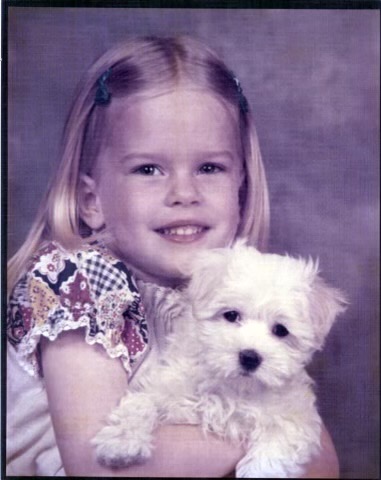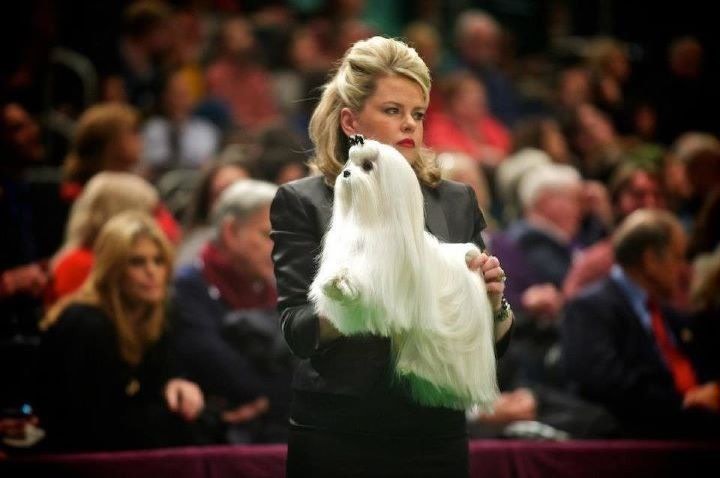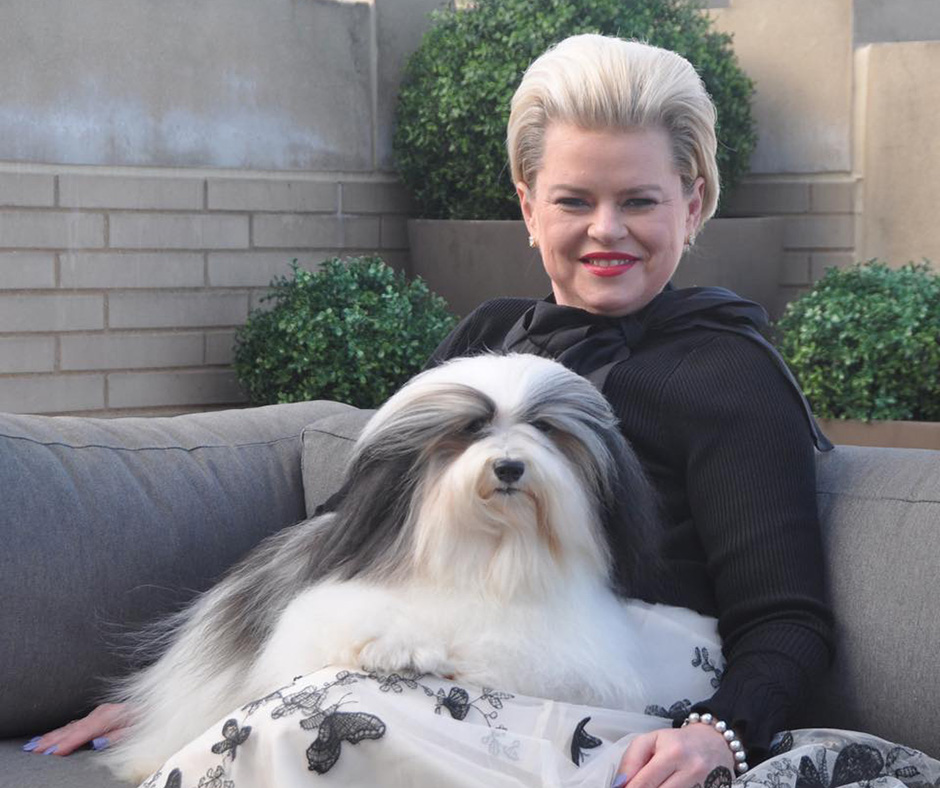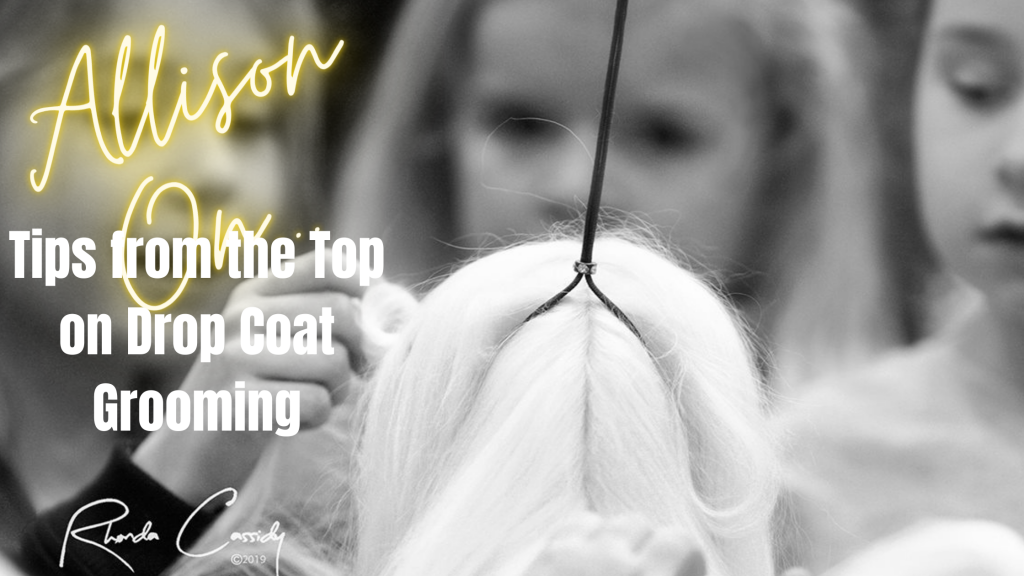580 – Tara Martin Rowell on Drop Coats and Competitive Spirit
Tara Martin Rowell on Drop Coats and Competitive Spirit
Tara Martin Rowell, breeder, handler and second generation dog woman, joins host Laura Reeves with recommendations on maintaining drop coats, the genetics of her competitive spirit and pro tips for succeeding at the highest level in the sport.

Tara Martin Rowell in her formative years with Maltese.
“Basically, I was born into Maltese,” Tara said. “My mom (AKC judge Vicki Abbott) and dad had me right after my mom had kind of gotten involved in the breed. In my younger life, it was all about the Maltese and my mom was very successful. (She) had the top winning toy dog of all time, a Maltese that she actually handled. That’s how I got introduced into dog shows as a young child.
“Something that I always say when people ask me, I think it’s very important, especially today for our younger generation, to at least get some sort of a business degree. You want to handle dogs, you got to know how to do the business side of it too, because it’s not just the glamour and the walking in the ring and the winning. I mean, that’s very small portion of it.

Tara Martin Rowell with Hank, GCH CH Scylla Small Kraft Re-Lit. Bred by Tara and her mom, Vicki Abbot. Owned by Ron Scott and Debbie Scott.
“I started my life picking up a lot of poop. A lot of dogs that I never walked in the ring with doing a lot of holding of dogs, doing a lot of keeping my mouth shut. I mean, there’s a lot of work that goes into that process of success, you know?
Favorite Dog Book
“I think Dog Steps would be the one everybody has to read. I think that you should reread it as you get older, especially if you’re aspiring to judge, even if you’ve been judging. I still think structure and anatomy is so important in a breeding program. In a breed like my main breed Maltese, I think people get away from the structure and the anatomy because they think the hair is so important. Hair’s very important, but it’s one piece of the puzzle that makes the whole puzzle work, and you can’t have one without the other.
Listen to the full episode for Tara’s recommendations on grooming routines, favorite products and secrets for success.
465 – Allison On: Tips from the Top on Drop Coat Grooming
Allison On: Tips from the Top on Drop Coat Grooming
Allison Alexander, founder of Leading Edge Dog Show Academy and President of the Canadian Professional Handlers Association, joins host Laura Reeves to talk about grooming drop coated breeds, from maintenance to polish.
Allison’s years of experience provide enormous insight into the maintenance on coated breeds from a Maltese to a Briard. Along with professional tips on the tools of the trade…. What kind of pin brush, what type of wraps, HOW to wrap and band. We cover it all right here. Read on for just the tip of the iceberg. And click to listen to the entire fabulous conversation.
“Obviously the basics start with line brushing,” Allison said. “And one thing I will say about drop coats, and people might disagree with me, but drop coats more than any other coat type, you can’t have a bad day.
“Even a poodle in full show coat, you can skip a bath. They could get wet in a rainstorm or snowstorm and it’s midnight and you’ve driven for two days to get home and, I’m not recommending it, but you can let them get away with like towel him dry, sleeping it off overnight and starting the next day. You have a long coat, especially as single-coated long coat, and you do not have those options.
“So the commitment is like times 10 to me. There are no days off. So when it comes to line brushing to me to keep a really fully coated drop coat breed in coat, line brushing has to be something that you’re doing every day. You’re going to change those wraps every day. You’re going to change that topknot every day. You’re going to make sure that they look perfect.
“When it comes to line brushing, my kind of general rule of thumb is, the longer the coat the more coat they have, the longer the pin in the pin brush. When it comes to a single-coated drop coat, I’m going to use a brush with a slightly softer pad firmness. The double-coated drop coats, I’m going to use a brush that has a slightly firmer pad that the pins go in.
“We also know that no matter what we’re brushing, but again more important for long coats, never, ever brush the coat dry. You need some kind of brushing spray, whether it’s a brushing spray that’s just cutting down on static, whether it’s one that’s adding some kind of conditioner to the coat or whether it’s a detangling brushing spray. But they cannot be brushed dry. You’ll just keep snapping those ends off.
“When I am line brushing, I like to teach my dog to lay down on their side. Especially a drop coat because obviously, with that longer outer coat hanging down, you’re not going to get underneath. So if you’re drop coated dog is standing up, even if it’s a Skye terrier, even if it’s a Briard, how are you going to hold all of that coat up out of your way. You’re not going to be able to do that. So the first thing you can do is teach your dog to lay down on the table.
“Remember that our grooming tables are fabulous, they have non slip surfaces, but they are not the thing that our dog really wants to lay on. When I’m laying my dogs down to be line brushed, they typically have maybe a yoga mat, a grooming mat or like a thin dog bed, at the very least a nice thick bath towel underneath them. Mine typically have some kind of grooming mat and then a nice thick bath towel underneath them so that they’re comfortable. ‘Cause you’re going to be here for awhile.
“You’re going to start at the very shortest hair like as far down on the belly as you can and then I like to take the sections when I’m line brushing… so line brushing actually means going line by line through the coat… you have to create those lines. So, you’re creating those lines, typically you could use a knitting needle. I like to use a plastic rat tail comb. Some people use a metal rat tail comb, some people get really good at using their fingers.
“I like to go about a finger width between each line ’cause sometimes people are lined brushing but they’re using like 3 inches of code at a time and wondering why they’re not getting the same results so a fingers width. Obviously like on a little dog like a Maltese it probably would be my little finger and probably on a bigger dog like a Skye terrier, a Briard, it would be like a bigger finger.
“You’re going to take a layer coat, you’re going to mist it with whatever your brushing spray is, brush it with your pin brush, check it with your comb. We’re not using our comb to groom the dog because otherwise you’re going to be removing too much coat. We’re using the comb to check that we did get all the way down to the skin from one end of that line that we did (to the other.)
“Typically I’m going to go from the belly to the top line. Then I’m going to do each leg in the same manner. I don’t typically do the legs or the tail or the neck at the same time. I go from the armpit to the loin area all the way up from the belly. Then I’m going to the front leg from the bottom of the foot up. Back leg, under the tail, the tail, then the neck. It’s in sections. An it’s line by line by line.”


